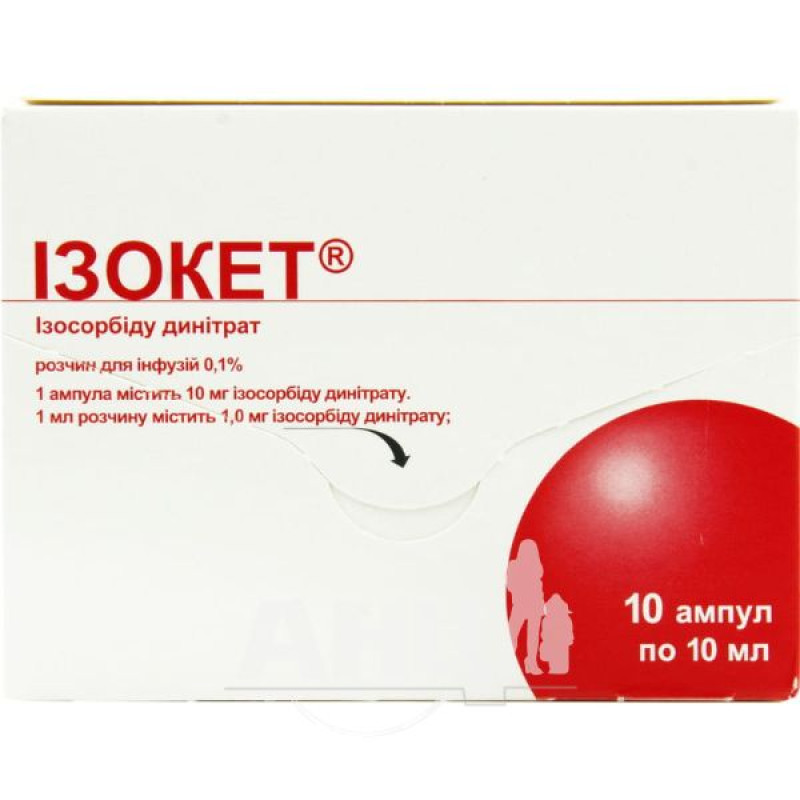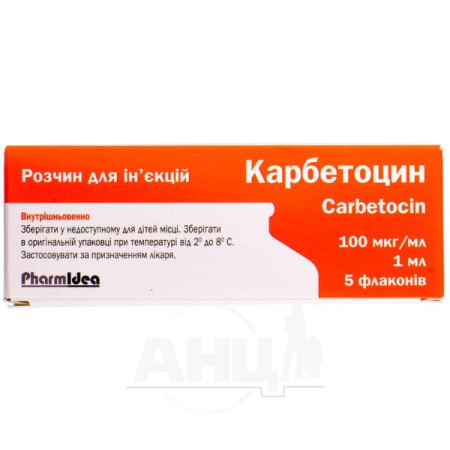Isoket solution for infusions 0.1% ampoule 10 ml No. 10

Pharmacological properties
Pharmacodynamics. Isosorbide dinitrate is an antianginal agent, a vasodilator, which acts mainly on venous vessels, and also relaxes arteries. This reduces the volume of venous return to the heart; thus, ventricular end-diastolic pressure and volume (preload) are reduced. The effect on arteries, and in higher doses on arterioles, leads to a decrease in systemic vascular resistance (afterload). This, in turn, facilitates the work of the heart. The effect on both pre- and afterload leads to a further decrease in the heart's need for oxygen. In addition, isosorbide dinitrate causes a redistribution of blood flow to the subendocardial parts of the heart, if the coronary circulation is partially obstructed by atherosclerotic lesions. This effect is probably due to the selective dilation of large coronary vessels. Dilation of collateral arteries caused by nitrates can improve perfusion of ischemic areas.
In patients with congestive heart failure, nitrates improve hemodynamics at rest and during exercise. In coronary artery disease, isosorbide dinitrate increases exercise tolerance. The drug also relaxes bronchial muscles, as well as muscles of the gastrointestinal, biliary, and urinary tracts. Isosorbide dinitrate acts as a nitric oxide (NO) donor, which leads to relaxation of vascular smooth muscle by stimulating guanylyl cyclase and subsequently increasing the concentration of cGMP; the latter is considered a mediator of relaxation.
Pharmacokinetics. T ½ of isosorbide dinitrate after i / v infusion is 20 min. Isosorbide dinitrate is metabolized in the liver to form isosorbide-2-mononitrate and isosorbide-5-mononitrate with T ½, which are 1.5-2 h and 4-6 h, respectively. Both metabolites are pharmacologically active. The drug is excreted in the urine, almost entirely in the form of metabolites. The bioavailability of the drug is 25%.
Indication
Unstable angina, acute myocardial infarction, acute left ventricular failure, to facilitate revascularization, as well as to prevent or increase the duration of revascularization, as well as to prevent or reduce the severity of coronary spasm during percutaneous transluminal coronary angioplasty.
Application
The drug is used intravenously or intracoronarily for intensive care in adults exclusively in a hospital setting! The dose is determined individually, taking into account the clinical picture and condition of the patient, with constant monitoring of clinical and hemodynamic parameters.
Intravenous administration. Therapy is started with a dose of 2 mg/h, gradually increasing it to the required to ensure optimal therapeutic effect. The average dose is 7.5 mg/h. The maximum dose usually does not exceed 10 mg/h, but in patients with heart failure this dose can be increased to 10-50 mg/h. For intravenous administration, only diluted drug is used!
Intracoronary administration. Used during percutaneous transluminal coronary angioplasty. Usually the drug is administered as a bolus injection before balloon inflation at a dose of 1 mg. Then the drug can be administered over 30 minutes in doses not exceeding 5 mg.
Method of application
A 0.1% solution of the drug is administered:
pre-diluted, in the form of continuous intravenous infusion using automatic infusion systems;
undiluted using a syringe pump, in a hospital setting with constant monitoring of cardiovascular system parameters. Depending on the disease and its severity, invasive methods are used to determine hemodynamic parameters in addition to the usual examination (symptoms, blood pressure, heart rate, diuresis). Ampoules must be opened under aseptic conditions, immediately before use. The diluted solution should be used immediately.
Preparation of solutions of different concentrations:
0.1 mg/ml (0.01%): Dilute 50 ml of the drug (5 ampoules of 10 ml) to a volume of 500 ml with one of the solutions listed below.
0.2 mg/ml (0.02%): Dilute 100 ml of the drug (10 ampoules of 10 ml) to a volume of 500 ml with one of the solutions listed below.
Dilution solutions: saline, 5-30% glucose solution, Ringer's solution, solutions containing albumin.
The drug can also be administered undiluted: 1 ml of the drug contains 1 mg of isosorbide dinitrate. Usually, the drug is administered intracoronarily in this way.
Contraindication
Hypersensitivity to isosorbide dinitrate, other nitrate compounds or other components of the drug; acute vascular insufficiency (shock, vascular collapse); in case of cardiogenic shock, if it is impossible to correct the end-diastolic pressure of the left ventricle by appropriate measures; severe arterial hypotension (systolic pressure 90 mm Hg, diastolic pressure 60 mm Hg); hypertrophic obstructive cardiomyopathy; constrictive pericarditis; cardiac tamponade; primary pulmonary diseases (given the risk of hypoxemia, which may be caused by redistribution of blood flow to areas of hyperventilation); toxic pulmonary edema; conditions accompanied by increased intracranial pressure (hemorrhagic stroke, traumatic brain injury); children under 18 years of age; breastfeeding period.Side effects
When first used or when the dose of the drug is increased, a sharp decrease in blood pressure and/or orthostatic hypotension may occur, which may be accompanied by a reflex increase in pulse rate, inhibition, as well as dizziness and a feeling of weakness. At the beginning of treatment, a headache (nitrate headache) may occur, which usually disappears after a few days with continued use of the drug.
In isolated cases, with a significant decrease in blood pressure, an increase in the severity of angina symptoms may occur.
Extremely rarely, collaptoid states are observed, sometimes with bradycardia and syncope (attacks with sudden loss of consciousness, dizziness, associated with impaired cerebral circulation due to a significant slowdown in heart rate). In some cases, redness and allergic skin reactions are possible, exfoliative dermatitis may be observed. In isolated cases, nausea and vomiting may occur.
Special instructions
The drug should be prescribed with extreme caution and under constant medical supervision for:
low filling pressure, in particular in acute myocardial infarction, impaired left ventricular function (left ventricular failure). It is necessary to avoid a decrease in systolic blood pressure of 90 mm Hg; aortic and / or mitral stenosis; tendency to orthostatic reactions; diseases accompanied by increased intracranial pressure (although to date, cases of increased intracranial pressure have been noted only after intravenous administration of nitroglycerin in high doses).When using the drug, cases of tolerance (reduced effect) and cross-tolerance to other nitrates (reduced effect in the case of previous therapy with another nitrate) have been described. To prevent a decrease or loss of effectiveness, prolonged administration of large doses of the drug should be avoided, after 3-6 weeks of regular use of the drug, a break of 3-5 days should be taken, using other antianginal agents during this period.
For infusion of the drug, systems made of polyethylene, polypropylene or polytetrafluoroethylene can be used. It has been found that infusion systems made of polyvinyl chloride or polyurethane lead to loss of active substance by adsorption. In case of urgent need to use such systems, the dose of the drug should be increased.
Since Izoket is a supersaturated solution of isosorbide dinitrate, sometimes, when using the undiluted drug, a crystalline precipitate may appear. If crystals are present, it is safer not to use the solution, although its effectiveness is not changed. The drug is not prescribed to patients who have recently taken phosphodiesterase inhibitors (for example, sildenafil).
Use during pregnancy and breastfeeding. Use during pregnancy with caution and only when the expected benefit to the mother outweighs the potential risk to the fetus. If necessary, breastfeeding should be discontinued.
Children: There is no experience with the use of the drug in children under 18 years of age.
Ability to influence the reaction speed when driving vehicles or working with mechanisms. During the treatment period, it is not recommended to drive vehicles and engage in other potentially dangerous activities, since regular use of isosorbide dinitrate reduces the ability to concentrate and the reaction speed.
Interactions
It is possible to enhance the hypotensive effect when using the drug simultaneously with β-adrenergic blockers, calcium channel blockers, vasodilators), and when used with sympathomimetics (noradrenaline, mezaton) - suppression of the antianginal effect. The drug is not prescribed to patients who have recently taken phosphodiesterase inhibitors (for example, sildenafil). When using the drug simultaneously with neuroleptics and cyclic antidepressants, opioid analgesics, ethanol and drugs containing ethanol, it is possible to enhance the hypotensive effect. The combined use of isosorbide dinitrate with dihydroergotamine can lead to an increase in the concentration of dihydroergotamine in the blood and thus enhance its effect. The use of isosorbide dinitrate against the background of quinidine or novocainamide can cause orthostatic collapse. When used with heparin, a decrease in anticoagulant effect is possible. In heart failure, cardiac output improves when used simultaneously with hydralazine. Atropine and other drugs that have m-cholinoblocking effects (etatsizine, moracisin) can reduce the vasodilating effect of isosorbide dinitrate. Sulfhydryl group donors (captopril, acetylcysteine, unitiol) restore reduced sensitivity to the drug.
Overdose
Symptoms: a sharp decrease in blood pressure to ≤90 mm Hg; pallor; increased sweating; weak pulse filling; tachycardia; dizziness (including orthostatic reactions when changing body position); headache; weakness; nausea; vomiting; diarrhea.
Cases of methemoglobinemia and cyanosis followed by tachypnea, anxiety, loss of consciousness, and cardiac arrest have been reported in patients receiving other nitrates.
Treatment. General measures: stop the drug from entering the human body; place the patient in a horizontal position with the head down and legs raised; ensure oxygen supply; increase the BCC, and conduct special anti-shock therapy in the intensive care unit.
Special measures: increase blood pressure if it is very low; use noradrenaline hydrochloride or other vasoconstrictors. The use of adrenaline (epinephrine) is contraindicated. Blood transfusion, hemodialysis can be used.
Treatment of methemoglobinemia: vitamin C 1 g orally or IV. Methylene blue up to 50 ml of 1% IV solution. Toluidine blue initially 2-4 mg/kg IV, subsequently, if necessary, doses of 2 mg/kg can be repeated at 1-hour intervals.
Resuscitation measures: in case of respiratory or cardiac arrest, resuscitation measures should be performed immediately.
Storage conditions
At a temperature not exceeding 25 °. the diluted drug should be administered within 24 hours.
There are no reviews for this product.
There are no reviews for this product, be the first to leave your review.
No questions about this product, be the first and ask your question.

